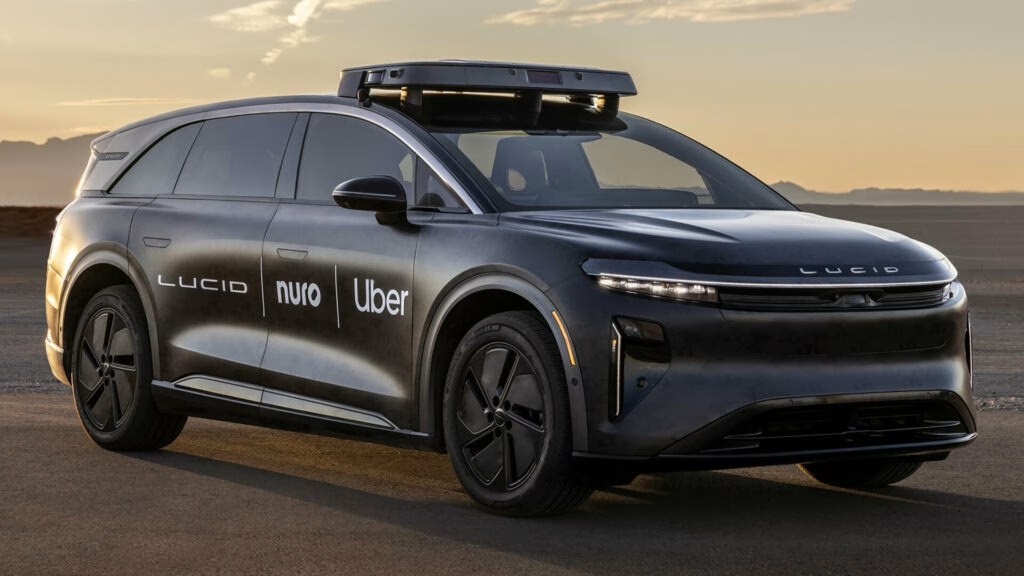How Will Uber’s New Robotaxi Service Actually Work?
Uber is preparing to roll out a robotaxi service powered by the Lucid Gravity SUV, marking a major leap for both ride-hailing and electric vehicle technology. Here’s the gist: Uber, Lucid, and Nuro have teamed up to put more than 20,000 autonomous Lucid vehicles on the road over the next six years. The first wave is set to launch in a major US city next year, though the exact location is still under wraps.
What makes this partnership stand out is the blend of luxury, tech, and scale. Lucid, known for its long-range, high-performance EVs, is stepping into the limelight after flying under the radar for years. For context, Lucid delivered just over 10,000 vehicles last year—so this deal is a game-changer for their visibility and growth.
What’s Special About the Lucid Gravity Robotaxi?
If you’re picturing a regular Lucid Gravity with a few sensors slapped on, think again. The prototype revealed by the companies features a roof-mounted pod bristling with cameras and sensors, giving it a 360-degree view of its surroundings. This hardware is crucial for the Nuro Driver, a Level 4 autonomous driving system that’s already being put through its paces at a Las Vegas test facility.
The Gravity’s advanced tech platform, redundant electrical systems, and impressive range (up to 440 miles, according to Lucid) make it a natural fit for the demands of robotaxi service. All the self-driving hardware will be installed right on Lucid’s assembly line, and the vehicles will get Nuro’s software once Uber is ready to deploy them. The result? A purpose-built, luxury robotaxi that’s designed for reliability and scale.
How Will Riders Experience the Service?
Uber plans to own or partner with third-party fleets to operate these robotaxis, making them available exclusively through the Uber app. For riders, the experience should feel seamless: you’ll hail a ride as usual, but your driver will be a Lucid Gravity piloted by Nuro’s autonomous system.
Safety and comfort are front and center. The Gravity’s spacious, upscale interior and smooth electric drive should make for a pleasant ride—no more awkward small talk with drivers, unless you’re really going to miss it. And with the vehicle’s sensors and AI constantly monitoring the environment, the system is designed to handle city traffic with precision.
Why Is This a Big Deal for Lucid and Uber?
For Lucid, this partnership is a massive boost. The company has struggled with brand awareness despite rave reviews for its vehicles. Now, with Uber planning to deploy at least 20,000 Lucid robotaxis worldwide, millions of riders will get firsthand experience with Lucid’s tech and luxury. It’s a marketing coup and a major validation of their engineering.
Uber, meanwhile, is betting big on autonomy. CEO Dara Khosrowshahi has said that autonomous vehicles have the potential to transform cities for the better. By investing $300 million into Lucid and making a multi-hundred-million-dollar commitment to Nuro, Uber is signaling that it sees robotaxis as the future of urban mobility. The company’s scale and data give it a unique edge in rolling out this technology quickly and efficiently.
What About the Technology Behind the Scenes?
The heart of the system is Nuro’s Level 4 autonomous driving platform. Level 4 means the vehicle can handle all aspects of driving in certain conditions without human intervention—think city streets, mapped routes, and predictable environments. The Gravity’s suite of sensors, including lidar, radar, and high-resolution cameras, feed real-time data to the AI, allowing it to make split-second decisions.
This isn’t just theoretical. The first prototypes are already being tested in controlled environments, and the companies are working closely with regulators to ensure safety and compliance. According to a 2023 report from the National Highway Traffic Safety Administration, autonomous vehicles have the potential to reduce traffic fatalities by up to 90% once widely adopted, thanks to their ability to eliminate human error.
How Will This Impact Cities and Everyday Commuters?
The promise of robotaxis goes beyond convenience. Autonomous fleets could help reduce congestion, lower emissions, and make transportation more accessible. For cities, fewer private cars and more efficient shared rides could mean less traffic and cleaner air. For commuters, it’s about reclaiming time—imagine catching up on emails or just relaxing during your ride, no hands on the wheel required.
Of course, there are challenges. Questions remain about how these vehicles will interact with pedestrians, cyclists, and unpredictable urban scenarios. There’s also the matter of public acceptance—will riders trust a car with no human driver? Early studies suggest that trust builds quickly with positive experiences, but it’s something Uber and Lucid will need to manage carefully.
What’s Next for Autonomous Ride-Hailing?
The Uber-Lucid-Nuro partnership is just the tip of the iceberg. As technology matures and regulations catch up, expect to see more automakers and tech companies jump into the robotaxi race. The next few years will be a proving ground—not just for the technology, but for the business models and user experiences that will define the future of urban mobility.
The big takeaway? The robotaxi revolution isn’t about perfection—it’s about smarter adjustments. Start with one change this week, and you’ll likely spot the difference by month’s end. Whether you’re a daily commuter or just curious about what’s next, keep an eye on your city streets. The future of getting around might be pulling up to the curb sooner than you think.

